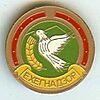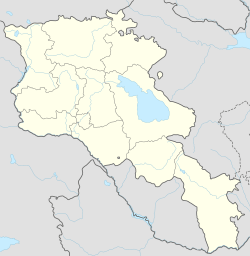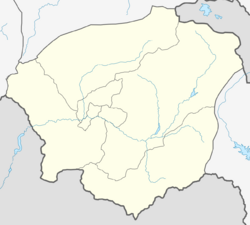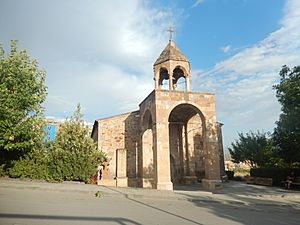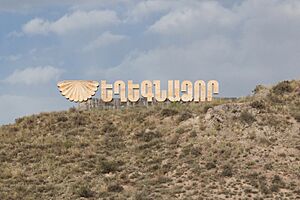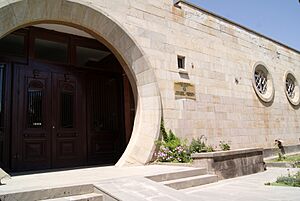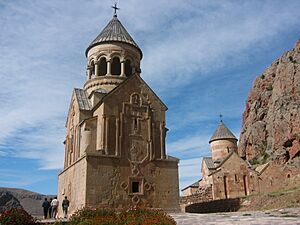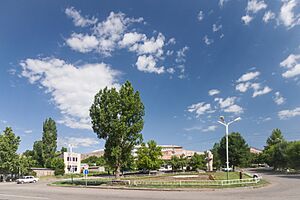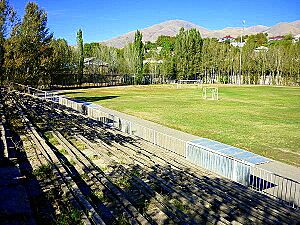Yeghegnadzor facts for kids
Quick facts for kids
Yeghegnadzor
Եղեգնաձոր
|
||
|---|---|---|
|
Town
Urban Community |
||
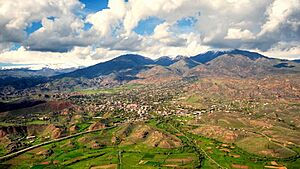 |
||
|
||
| Country | ||
| Province | Vayots Dzor | |
| Municipality | Yeghegnadzor | |
| First mentioned | 5th century | |
| Area | ||
| • Total | 278 km2 (107 sq mi) | |
| Elevation | 1,194 m (3,917 ft) | |
| Population
(2011)
|
||
| • Total | 7,944 | |
| • Density | 28.58/km2 (74.01/sq mi) | |
| Time zone | UTC+4 (AMT) | |
| Area code(s) | (+374) 281 | |
| Website | Official website: http://www.yeghegnadzor.am | |
| Yeghegnadzor at GEOnet Names Server | ||
Yeghegnadzor (Armenian: Եղեգնաձոր) is a town in southern Armenia. It serves as the capital of the Vayots Dzor Province and the Yeghegnadzor Municipality. The town is about 123 kilometers (76 miles) south of Yerevan, the capital of Armenia.
Yeghegnadzor is located on the banks of the Srkghonk River. It sits at a height of 1,194 meters (3,917 feet) above sea level. In 2011, the town had a population of 7,944 people. Yeghegnadzor is also an important religious center for the Armenian Apostolic Church.
Contents
What does the name Yeghegnadzor mean?
The name Yeghegnadzor comes from two Armenian words. Yegheg (Armenian: եղեգ) means cane, and dzor (Armenian: ձոր) means valley. So, the town's name means "valley of canes".
A brief history of Yeghegnadzor
The area where Yeghegnadzor is located has been settled for a very long time. Scientists have found parts of an old cemetery and a tomb from about 1,000 BC. An ancient fortress from the Urartian kingdom, built around 700 BC, is also nearby.
Early mentions and medieval times
The town was first called Pondzatagh in the 5th century. In the early 800s, a prince named Philip moved his home to this area. This is when the name Yeghegnadzor or Yeghegyats Dzor became widely used.
During the Middle Ages, an important trade route called the Silk Road passed through this region. Many churches, monasteries, bridges, and places for travelers (caravanserais) were built here. This was between the 10th and 13th centuries, when Yeghegnadzor was part of the Kingdom of Syunik.
Under Persian and Russian rule
In the early 1500s, Eastern Armenia, including Yeghegnadzor, came under the rule of the Persian Empire. This period was difficult for the town. It became a battlefield, and many villages were destroyed. In 1747, Yeghegnadzor became part of the Nakhichevan Khanate. By the 1800s, the town was known as Keshishkend.
In 1828, after a war between Russia and Persia, Yeghegnadzor became part of the Russian Empire. Many Armenian families from Persia moved to this area. The town was then part of the Sharur-Daralagezsky Uyezd within the Erivan Governorate.
Modern history
Between 1918 and 1920, Yeghegnadzor was part of the short-lived First Republic of Armenia. After Armenia became part of the Soviet Union, the town was a center of resistance. It was part of the unrecognized Republic of Mountainous Armenia. However, it eventually became part of the Armenian SSR in 1921.
The town was called Keshishkend until 1935. Then it was renamed Mikoyan after a Soviet leader. On December 6, 1956, the town got its historical name back: Yeghegnadzor. After Armenia became independent in 1991, Yeghegnadzor became the capital of the new Vayots Dzor Province in 1995.
Geography and climate of Yeghegnadzor
Yeghegnadzor is located at 1,194 meters (3,917 feet) above sea level. The land around the town is mostly semi-desert at lower and middle heights. The town is built on both sides of the Srkghonk River, which flows into the Arpa River. The village of Gladzor is right next to Yeghegnadzor to the north.
Weather patterns
Yeghegnadzor has a climate with hot summers and snowy winters. The average rainfall is about 400 mm per year. In January, the average temperature is around 5-6°C (41-43°F), but it can get as cold as -22°C (-8°F). In July, it can reach up to +35°C (95°F).
| Climate data for Yeghegnadzor | |||||||||||||
|---|---|---|---|---|---|---|---|---|---|---|---|---|---|
| Month | Jan | Feb | Mar | Apr | May | Jun | Jul | Aug | Sep | Oct | Nov | Dec | Year |
| Mean daily maximum °C (°F) | 0.9 (33.6) |
3.0 (37.4) |
9.5 (49.1) |
16.4 (61.5) |
21.1 (70.0) |
26.0 (78.8) |
30.3 (86.5) |
29.5 (85.1) |
25.9 (78.6) |
18.7 (65.7) |
10.8 (51.4) |
4.1 (39.4) |
16.3 (61.4) |
| Daily mean °C (°F) | −3.2 (26.2) |
−1.4 (29.5) |
4.2 (39.6) |
10.4 (50.7) |
14.8 (58.6) |
19.2 (66.6) |
23.1 (73.6) |
22.4 (72.3) |
18.5 (65.3) |
12.3 (54.1) |
5.7 (42.3) |
0.1 (32.2) |
10.5 (50.9) |
| Mean daily minimum °C (°F) | −7.3 (18.9) |
−5.7 (21.7) |
−1.0 (30.2) |
4.4 (39.9) |
8.6 (47.5) |
12.4 (54.3) |
16.0 (60.8) |
15.4 (59.7) |
11.2 (52.2) |
5.9 (42.6) |
0.7 (33.3) |
−3.9 (25.0) |
4.7 (40.5) |
| Average precipitation mm (inches) | 17 (0.7) |
20 (0.8) |
35 (1.4) |
45 (1.8) |
62 (2.4) |
47 (1.9) |
31 (1.2) |
19 (0.7) |
18 (0.7) |
30 (1.2) |
25 (1.0) |
19 (0.7) |
368 (14.5) |
| Source: Climate-Data.org | |||||||||||||
Local wildlife
The areas around Yeghegnadzor are home to various animals. You might find mammals like bezoar ibex, wolves, and foxes. There are also reptiles such as adders and vipers. Birds like partridges and sparrows live here too.
Culture and traditions
Yeghegnadzor is the biggest town and the cultural center of the Vayots Dzor Province. It has a cultural palace, a public library, and a regional museum. The town also has an art school, a sports school, and a music academy.
Festivals and celebrations
People in Yeghegnadzor enjoy celebrating religious and traditional holidays like Trndez and Vardavar. The most popular event is the harvest festival. It happens every year on the second Sunday of October. People from nearby villages come with their crops and berries. There are parades, shows, and concerts.
Yeghegnadzor cheese
Yeghegnadzor is famous for its unique cheese. This cheese is made from cow's or goat's milk, mixed with local mountain greens. It's stored in clay pots and buried in the mountains to age for at least six months. The cheese has a strong, salty flavor and a semi-soft, crumbly texture.
Historical monuments to explore
- Cathedral of the Holy Mother of God: This church was built in the 12th century and renovated in 1878. It's in the center of Yeghegnadzor.
- Proshaberd fortress: Also known as Boloraberd fortress, it dates back to the 13th century. It's a few kilometers northeast of Yeghegnadzor.
- University of Gladzor: This historic university from the 13th century is located in the village of Gladzor, near Yeghegnadzor.
- Noravank monastic complex: This beautiful monastery from the 13th century is a few kilometers southwest of the town.
- Spitakavor Monastery: Built in 1321, this monastery is just north of Yeghegnadzor, near the village of Vernashen.
Economy and industry
The economy of Yeghegnadzor mainly relies on construction and food processing. The town has several wineries, including Maran Winery (opened 1992) and Old Bridge Winery (opened 1998). There's also the Golden Goat cheese factory (opened 2000) and a cannery (opened 2015).
Other businesses include "Rafelgrig" for electrical products and "Izoton" which makes oak barrels for wine and brandy. The town also has smaller businesses that produce building materials, textiles, handmade carpets, and jewelry. Farming, raising animals, and beekeeping are also important activities in the areas around Yeghegnadzor.
Education in Yeghegnadzor
Yeghegnadzor has several educational institutions. The Gitelik Yeghegnadzor University opened in 2004 and has 12 different departments. The Yeghegnadzor campus of the Armenian State University of Economics has been operating since 2008. As of 2016, the town has four public schools and three kindergartens. The Royal Victorian University Educational Foundation of Armenia (RVU) is also based here.
Sports in Yeghegnadzor
The town used to have a football club called Arpa FC (originally Momik FC), which played in the Armenian Premier League. However, the club stopped playing professionally in 2003. The Yeghegnadzor City Stadium, opened in 1985, can hold about 500 spectators.
Notable people from Yeghegnadzor
- Kamsar (Kamo Sahakyan), a famous Armenian painter.
- Jaklin Baghdasaryan, an Armenian singer.
Images for kids
-
Memorial to the victims of the First Nagorno-Karabakh War.
See also
 In Spanish: Yeghegnadzor para niños
In Spanish: Yeghegnadzor para niños


